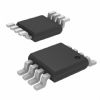DescriptionThe MAX4970/MAX4971/MAX4972 feature an enable input (EN)that controls the operation of the internal nFET as well as the optional external pFET. The use of EN allows the external pFET to block reverse voltages independent of any signal present at the output. The overvoltage thresholds (OVLO)are preset to 4.65V (MAX4972), 5.8V (MAX4970), or 6.35V (MAX4971). The MAX4970/MAX4971/MAX4972 family of overvoltage protection devices features a low 40m (typ)RON internal FET and protect low-voltage systems against voltage faults up to +28V. These devices also drive an optional external pFET to protect against reverse-polarity input voltages. The autoretry interval time is 15ms, and if the fault is removed, the MOSFET remains on. The undervoltage thresholds (UVLO)are preset to 2.45V. When the input voltage drops below the UVLO, the devices enter a low-current standby mode. All devices are offered in a small 12-bump, WLP package and operate over the -40°C to +85°C extended temperature range. When the input voltage exceeds the overvoltage threshold, the internal FET is turned off to prevent damage to the protected components. All switches feature a 2.3A (min)current-limit protection. During a short-circuit occurrence, the device operates in an autoretry mode where the internal MOSFET is turned on to check if the fault has been removed.
The features of MAX4970 can be summarized as (1)input voltage protection up to +28V; (2)integrated nFETSwitch; (3)reverse voltage protection with external pFET; (4)enable input; (5)preset overvoltage protection trip level 5.8V (MAX4970)/ 6.35V (MAX4971)/ 4.65V (MAX4972); (6)low-current undervoltage-lockout mode; (7)short-circuit protection (autoretry); (8)internal 15ms startup delay and retry times; (9)input-voltage power-good logic output; (10)thermal-shutdown protection; (11)2mm x 1.5mm, 12-bump WLP package.
The absolute maximum ratings of MAX4970 are (1)IN: -0.3V to +30V; (2)IN-GP: (30V - 5.4V); (3)OUT: -0.3V to +(IN + 0.3)V; (4)EN, ACOK: -0.3V to +6V; (5)GP: -0.3V to +30V; (6)continuous power dissipation (TA = +70°C)for multilayer board: 12-Bump WLP (derate 8.5mW/°C above +70°C): 678mW; (7)WLP Package Junction-to-Ambient Thermal Resistance (JA)(Note 1): 118°C/W; (8)operating temperature range: -40°C to +85°C; (9)junction temperature:+150°C; (10)storage temperature range: -65°C to +150°C; (11)lead temperature (soldering): +300°C.

 MAX4970 Data Sheet
MAX4970 Data Sheet







